Labor Shortage Mystery of America
Where did all the employees go?
The Great Resignation. It is a newly coined term that has frequently appeared on the news since last year. Many have thought that it would get better when Covid-19 situation improves, but it never did. People who left their workplace are not returning, and people who remained at their post are now looking for a better opportunity or simply leaving the workforce. Now, employers are in serious trouble. For beauty supply owners whose heart drops to the floor when an employee says, “I need to talk to you for a minute,” we will discuss what has caused the current labor shortage and how to deal with it.
PART 1. Worst Labor Shortage in America
According to the statistic released in May 2022 by the U.S. Department of Labor, there are 1.15 million job openings while there are 6 million people unemployed. That means there are nearly two jobs available per a job seeker. On the other hand, voluntary resignation in the same month (March 2022) totaled 4.54 millions. Both job openings and resignation were record high in number.
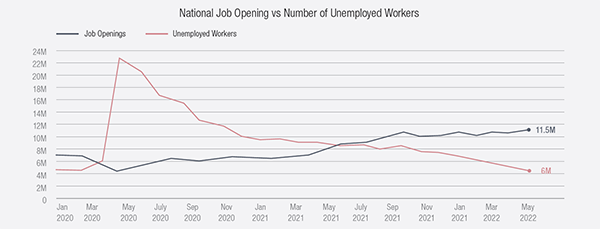
©U.S. Chamber of Commerce Analysis, BLS Data
When the pandemic was in its worst shape, more than 120,000 businesses shut down temporarily and more than 30 million workers lost their jobs. Afterwards, the labor market recovered quickly in the first half of 2020, but the unemployment rate did not go down at the same pace. Since last year, the impact of Covid-19 has lessened, but the great resignation continued where employees voluntarily quit or declined to come back. There is even a bleak prediction that this labor shortage can last several years.
The early assessment of experts that the labor shortage would disappear when the Covid-19 situation gets better and the government stimulus payment dries up has missed the mark entirely. As such, research institutions are racing to publish various analyses on the underlying causes of the labor shortage mystery in America.
Early retirement
Upon the Covid-19 pandemic, a lot of baby boomers retired. As of October 2021, more than 3 million people decided to retire citing their asset value increase and health concerns, and the number of adults over 55 who exited the labor force through retirement increased from 48.1% in the third quarter of 2019 to 50.3% in the fourth quarter of 2021.
Anti-work sentiment among Millennials and Gen Zs
Compared to the previous generations, more Millennials and Generation Zs value their life over work, and the pandemic changed their perception of work and deprived them of a sense of achievement at work. This anti-work sentiment has been cited by many as a main culprit behind the labor shortage. *However, according to the statistics of the U.S. Department of Labor, the employment rate of 25-54 surpasses that of 55 and over.
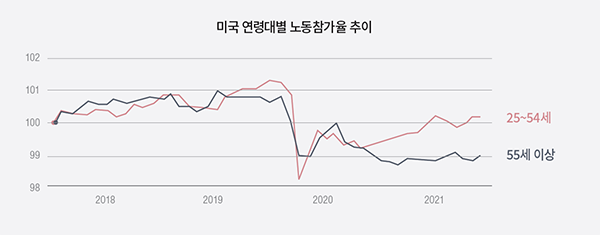
Economic stimulus payment
In contrast to European countries and Asian countries, the U.S. government chose to subsidize workers who are out of work rather than businesses. In fact, last September, 68% of the workers earned more in unemployment benefits than their regular salaries. The U.S. labor market had high volume in flows to and from employment, which became even higher due to the government subsidies according to the experts.
She-cession
Since February 2020, 2.3 million female workers left the workforce, and the labor force participation rate of women dropped to 57%, which is record low since 1988. While the numbers (58.3% as of May) are recovering this year, it is still 650,000 short compared to the pre-pandemic figure. The major causes of she-cession are school closings that lasted a long time and lack of childcare.
Less foreign workers
U.S. immigration started to decline after the anti-immigration policies were implemented by the Trump Administration since Trump took office in 2017. The visa processing virtually stopped due to Covid-19 and related closure of U.S. consulates while the sheer volume of immigration cases plummeted. The delay in work visas for those currently in the U.S. is also arguably a cause of the reduced number of foreign workers in the U.S.
Starting own business
Employees who experienced the volatile labor market have reassessed their career prospect, and many decided to start their own business after leaving their job or not returning. Last two years, almost 10 million new businesses were formed, and 4 million new businesses in 2020 alone.
According to surveys, many workers are still concerned about health risks related to Covid-19 and focusing on acquiring new skills and getting education before making a comeback. These complex factors have changed the labor market into job seeker’s market, so companies and employers are struggling to find more workers despite incentives such as higher wage and extraordinary benefits.
-Amazon: $17/h for new associates and $1,000 cash bonus; 750,000 hourly workers receive college tuition reimbursement.
-Walmart: increase in average hourly wage from $11 to $15; Employees attending college receive full tuition reimbursement.
-Burger King (New Jersey): $16-35/h for shift managers, immediate hire, no experience required.
-McDonald’s: average hourly wage increased to $15 at company owned restaurants, signing bonuses and free iPhones.
-Starbucks: average hourly wage for barista increased from $14 to $17.
-Target and Best Buy: minimum wage increased to $15/h.
-Costco: minimum wage increased to $17/h.
-Icon Parking: health insurance, annual salary increase, and pension for all employees (including parking assistants).
-Software company WANdisco: 4-day, 32 hours work week.
-Real estate investment platform Mind: $60,000 cash subsidy toward real estate investment for employees who worked 5 years at the company.
-United Airlines (Chicago): new temporary hires get $10,000 signing bonus.
*Signing bonus refers to a one-time cash incentive to new employees. These bonuses typically require the worker to stay employed with the company for a set time period.

In current climate, workers are not afraid of losing jobs. They know they can find another easily. Is this a good trend?
Labor shortage can fuel the inflation that is suppressing the U.S. economy. When the hourly wage rises across the industries, the companies charge more for the same service or product, which leads to inflation and demand for salary increase, creating a whirl pool of mutual feedback. In fact, last May, the U.S. Consumer Product Index (CPI) rose 8.6% compared to the same month last year, setting a new record in 41 years.However, for the same period, workers’ earnings adjusted for inflation decreased 3.0%.

©Tradingecomics.com
To suppress inflation, the Federal Reserve (or Fed) spiked the interest rates, which in turn weakened consumer confidence and further raised the fear of recession. In the end, the labor shortage and higher wages will create a crisis among both employers and workers.
PART 2. Labor shortage at beauty supplies
Beauty supplies offer relatively lower hourly wage among many retail industries, and smaller beauty supplies are struggling with the labor shortage. When you talk to people in the beauty supply industry, you can feel the gravity of the situation. While conducting interviews, many people asked if I know someone who can work at their store. Employees who left the retail floor due to the Covid-19 pandemic did not come back, and for months of posting hiring signs, no one ever applies. When you get to hire one or two luckily, they don’t last long. They often come back, but they quit again a few days later. When asked why they would do that, they said, “no idea.” There were many stories surrounding hiring. If you are located in the countryside, there are few eligible workers. If urban, there are so many businesses hiring at the moment, which creates competition.
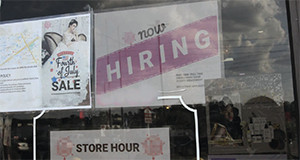
Hiring sign posted on a beauty supply store
Where did beauty supply workers go?
Hourly workers typically are not subject to exit interviews, so business owners have to make a wild guess. Sometimes, however, when a worker finds a new job at a neighboring store or comes back after working at a different place, you would know why they left. Through interviews, we could ask workers directly and have candid answers.
- -Last five years, big beauty supply stores, typically over 20,000 sq.ft. in size, popped up here and there. Many workers are flocking there. They typically pay more and have better work environment. It is hard to find workers if you are small. It used be that you could find workers through families and church members, but many older workers retired and left vacancy. -Store owner in Kentucky-
- Younger workers are simply not willing to work 10-11 hours a day. They prefer working at cell phone stores and restaurants. Cell phone stores don’t pay much, but you stay seated and store hours are short. At a restaurant, you get tips. Older workers may find jobs at grocery stores. -Store owner in Tennessee-
- African American workers head to McDonald’s, Walmart, Dollar General, and so on. But they tend to come back. At beauty supplies nobody really micromanage you, and you simply talk to customers and organize goods. So, I tried to re-hire those who came back, but they tend to miss works and being late. Eventually, they get fired for the same reason. So, I don’t re-hire workers who have left once. -Store owner in South Carolina-
- Students are flocking to restaurants as a server, and full-timers find entry-level cashier jobs at a large corporation. I have a friend who used to be a coworker but started working at an Amazon warehouse, and many benefits start at an entry-level job at such a large corporation. -Store employee in Georgia-
- I have a friend who opened an online store to sell eyelashes, and another who got pregnant lives on government benefits for low-income families. A former co-worker started working as a beauty consultant at Target three months ago, and I was told the hourly pay starts at $15 even if you do not have experience. The co-worker had beauty supply experience, so she is making $17/h and 150% for the weekends. I plan to make a move soon. -Store employee in Virginia-
Depending on ethnicity and age, you can see a different pattern. When you browse a community board, you would find a lot of job postings looking for Korean workers. Beauty supplies are of course frequent posters.
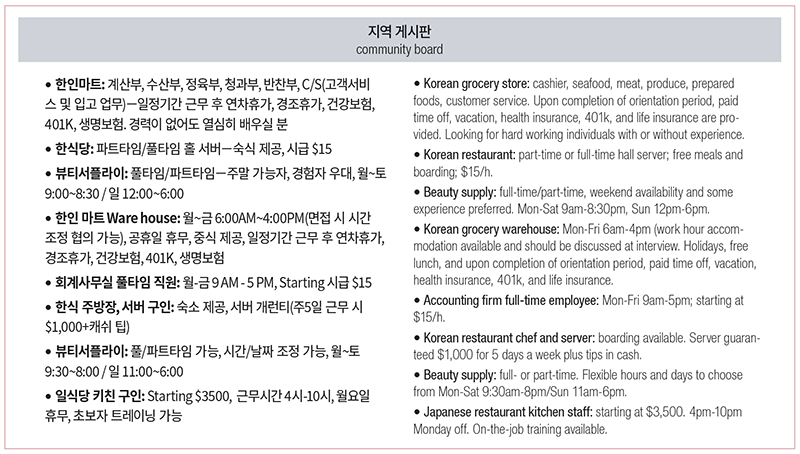
How to attract job applicants at beauty supplies?
Resume Builder surveyed workers and found that 1 in 3 workers are looking for a new job in a new career andthe biggest reason for the move is better pay and benefits. Personal passion and work environmentcame next. Why don’t you address those issues at your beauty supply?
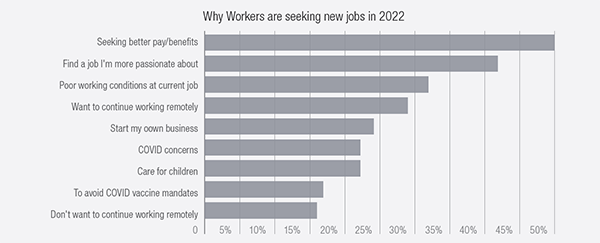
©ResumeBuilder.com
Wage
When asked if there was an increase in wage because of the labor shortage, most employers answered positively. In the past, inexperienced workers get paid $7-8/h, but now it starts at $10-13/h. However, last year the average hourly pay at restaurants and grocery stores surpassed $15 for the first time in American history. Hence, beauty supplies are still behind the pack for the hourly wage. If you want to keep up with the current trend, you should study the average wage in the industry, not the minimum wage. Online job listing platform Indeed reported that average hourly pay for retail in major cities as of March 2022 were as follows: $18.62 in New York City, $17.74 in Los Angeles, $16.67 in Chicago, $14.51 in Atlanta, and $14.35 in Miami. Of course, it would be impractical to raise the hourly wage overnight. However, the job seekers’ expectation is higher than ever. In fact, a story goes where a job applicant for a beauty supply allegedly asked them to match Costco’s hourly wage during a job interview.
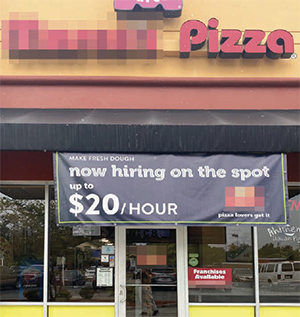
Hiring signage posted at a restaurant
Field talk
Store owner A: we run a three-month orientation and start at the legal minimum wage if no experience. Pay raise will be considered based on performance after the orientation period. We used to simply follow the minimum wage set by the State, but nowadays we are giving incentives to valuable employees.
Employee A: I work 5 days a week including weekends full-time as a cashier and wig section associate. I started in 2019 at $8.50/h and made $10/h in 2020, $13/h this year.
Employee B: I used to work around 20 hours a week, but now I’m working 30-40 hours a week because many of my coworkers quit during the pandemic. I started in 2020 at $11/h, made $12 in 2021 and $13 in 2022 with no benefit.
Benefits
A typical benefit package at retail business includes paid time off, health insurance, free meals and snacks, educational opportunities, 401(k), and gas and transportation reimbursement. Many beauty supplies also offer 20-30% employee discount at their store. For African American employees whose daily essential items are available at beauty supplies, it could be a substantial benefit.
Field talk
Store owner B: our staff is all African American, and the most senior employee has been with us for more than 10 years. I don’t have any special secrets. We simply reward their experience. For example, if a hair company provides a promotional sample, I would give it to my employees based on seniority. It doesn’t matter how expensive it is. If they feel rewarded, they work harder. It is also good for business. When an employee walks around wearing it, customers do ask.
Store owner C: because of the pandemic, we had high turnover. It felt like wasting resources on something that cannot be stopped. But insurance is essential to many employees who want the security of a regular job. We are seeking long-term partners, not seasonal employees, so we decided to provide the security of health insurance.
Employee C: Aside from pay, we get 30% employee discount and free samples and meals. If we get weekend and holiday x1.5 incentives like other retail stores, people might not so much hate weekend shifts.
Passion
Workers can get passionate and feel a sense of achievement when their values are recognized and they can have a vision. If you are the old school owner who says “just do as I say”, then you can try delegating certain tasks or more friendly approaches with employees. A workplace culture that provides a sense of belonging should be promoted. According to human resource expert Shonna Waters, workers with a strong sense of belonging showed increased job performance, clear decision making, and positive impact on mental health while isolation at the workplace led to stress, anxiety, and depression. It is time to review what your business is doing for the sense of belonging.
Field talk
Manager A: [Beauty Master] had 20th anniversary ceremony recently. A general manager with 19 years of employment and 12 employees with more than 5 years of employment were recognized with plaques and cash bonus, and the company issued dresses for employees to attend the big party. We are proud of our work culture and work with vision.
 Long Service Commemorative Plaque / At the 20th anniversary event, Beauty Master CEO Park Hyung-kwon(center) and staff
Long Service Commemorative Plaque / At the 20th anniversary event, Beauty Master CEO Park Hyung-kwon(center) and staff
Employee D: I am aspiring to be a hairstylist, and I believe this work experience help my career. Although it is not an easy work, I am still learning and mean to stay put for a while.
Employee E: Our staff is all Korean, but still we have conflict due to hierarchy and assignment. I believe having diverse staff members can contribute to good customer service and atmosphere.
Employee F: We have low pay with no security, so there is no incentive to stay. I wish not to be micro-managed. Should have some trust in employees. Being followed and directed in every detail can be very exhausting.
Work environment
Are beauty supplies good place to work? The answer should be highly subjective from employer to manager and staff members. To address labor shortage, you need to know what staff members think. The pros and cons of working at a beauty supply were clear from interviews with African American employees.
Field talk (with African American employees)
Pros
+Even though you are young and have no experience, it is easy to get a job. You can always come back as a seasonal employee during a school break.
+You can sell what you actually use. You get to know the new products before anyone else. There is joy from dealing with African American customers. I’m tuned to fashion and beauty, and when a customer compliments or asks questions about my makeup and hair, I feel a sense of achievement.
+In addition to the employee discount, meals at the break room are a plus. They are mostly Korean instant food, but if you are fond of Korean food, it is a good perk.
Cons
-Weekly schedules are posted too late, and people get assigned to different hours too often. It’s not rare to be notified of a schedule change just one or two days in advance.
-Dealing with rude customers. I think you have to deal with much worse beauty supplies than others. Low pay when you think about the workload. It is good for a part-time job, but not so much for a full-time job.
-If you can’t be on your foot all day, this is not for you. You are not allowed to use your phone other than during the break time, so if you have a child or someone you should care for, it may not work.
Feeling racial discriminated pops up in the list of cons.
Korean employees get an increase, or someone who doesn’t speak English gets promoted to a manager. African American employees are underappreciated. Now after three years I can communicate with the manager or owner much better, but at first, I felt weird when being watched while fetching merchandise from the storage. Theft is quite a major problem at beauty supplies, so I kind of understand. But it’s not a pleasant experience.
At first, I had restricted access to the cash register despite my previous experience as a cashier. Only Korean employees were assigned to the cash register. It is a business for the African American community, but the business lacks respect for the community it serves.
Labor shortage tips from beauty supply veterans
New school rational-thinking owner: some owners stick to Korean employees who are easier to work with. But I do believe you should hire African American employees too. They are good at sales, and customers are more comfortable with African American employees. Even if a Korean employee praises a product, a customer might ask, “have you tried it yourself?” Just don’t forget to have a written employment contract. You should have written rules about missing work among others.
Seasoned manager with decades of experience: we promote employees without regard to ethnicity. For good teamwork, they should understand each other’s culture. Some Korean employees complain that African American employees did not help them when they were moving heavy stuff. Well, they won’t help you unless you ask. On the other hand, African American employees who don’t speak Korean tend to complain that Korean employees raise their voices. Well, Koreans tend to raise their voices when they are in a hurry. Those small things can build up and create a chasm. Mutual appreciation and understanding is important.
Veteran owner who ran business for decades: I have my eyes on the inflation rate and average wage to offer an increase before they ask. I try to reward hard work. Wouldn’t you have less profit? Think selling more! The employer and employees are in the same boat. In difficult times, you work harder together to survive together.

Employment background check services
“You can’t ask for experience because having one is better than no one,” says a business owner. I do understand the sense of urgency. However, what if your new employee has a criminal record or plans to steal merchandise? What if they were rude to customers or complained after getting fired for cause? You shouldn’t ask a thief to watch over your store.
Before hiring, you should consider using employment background check services. Various service providers including Truthfinder, Instant Checkmate, Spokeo, US Search, PeopleFinders, and GoodHire offer background search at per-report pricing or monthly subscription at $20-30. Depending on the services, you can check criminal records, credit, work history, drug use, social media, and so on.